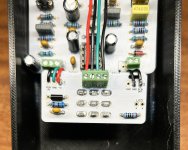Jono SPR Pedals
Member
- Build Rating
- 5.00 star(s)
My second forray into pedal building, having completed a Dielectric Boost before. A similar circuit, and another satisfying build that turned out really well. Hardest part of this build is that the LED holes didn't line up with the PCB so I have to solder wires from the board to the LED legs. If there's an easy / more elegant way to do that well I'd love to know your thoughts for next time. I put some heatshrink over the connections just in case. Happy to say that the pedal fired up first time I plugged it in with no issues. It sounded and reacted exactly how I expected, even down to the boost not really doing much until you push it past the 3 'o'clock setting. That's a characteristic of this pedal. I actually have a Les Lius on hand to A/B it with and it's very close between them. It's a great pedal to get those driven tweed tones, from Keef Richards, Joe Bonamassa and Neil Young.



